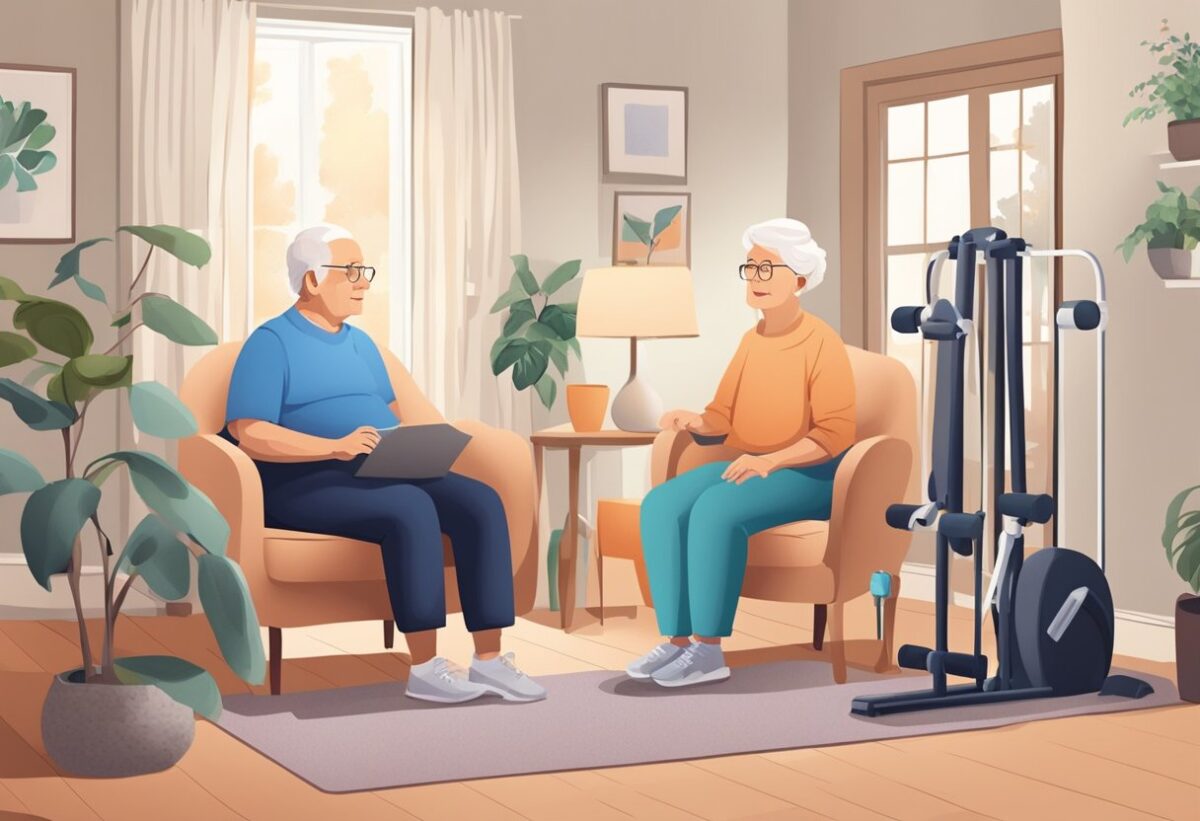In-home physical therapy for seniors offers a practical solution for those who need assistance with mobility and physical health while remaining in the comfort of their own homes. This approach minimizes the need for travel and allows for personalized care that addresses specific health concerns. This type of therapy can significantly enhance the quality of life for elderly individuals, promoting greater independence and well-being.
The need for in-home physical therapy can arise for various reasons such as recovery from surgery, dealing with chronic pain, or improving balance to prevent falls. Trained professionals provide tailored treatment plans that cater to the unique needs of seniors, ensuring they receive the right level of care. It’s important to consider the qualifications and experience of potential providers to ensure effective and safe outcomes.
Finding reliable in-home physical therapy services may require some research. Checking credentials, seeking recommendations, and evaluating the therapist’s track record can help in making an informed decision. Many areas have resources and agencies specifically dedicated to supporting seniors, making it easier to find quality care.
Key Takeaways
- In-home physical therapy helps seniors remain mobile and healthy at home.
- Consider the provider’s experience and credentials.
- Use local resources to find quality in-home physical therapy services.
Table of contents
- Key Takeaways
- Understanding In-Home Physical Therapy for Seniors
- Exploring the Benefits of In-Home Physical Therapy
- Identifying the Need for In-Home Physical Therapy in Seniors
- What types of physical therapy treatments are typically provided to seniors at home?
- What Should Be Considered When Choosing an In-Home Physical Therapy Provider for Seniors?
- How can I find quality in-home physical therapy services for the elderly in my area?
- Conclusion
- Frequently Asked Questions
Understanding In-Home Physical Therapy for Seniors
In-home physical therapy provides an effective way for seniors to receive the care they need within the comfort of their own home. It involves a licensed physical therapist visiting the patient’s home to provide personalized treatment.
Benefits of In-Home Physical Therapy
- Convenience: No need for transportation, which can be a significant challenge for many seniors.
- Personalized Care: Tailored to the individual’s specific needs and home environment.
- Safety and Comfort: Familiar settings can reduce anxiety and improve overall comfort levels.
Common Treatments Provided
- Strength Training: Exercises to maintain or improve muscle strength and endurance.
- Balance and Coordination Exercises: Helps reduce the risk of falls and improve mobility.
- Pain Management: Techniques such as massage and heat therapy to alleviate discomfort.
Roles and Responsibilities
Patient:
- Follow the therapist’s instructions.
- Maintain a safe and clean environment for sessions.
Therapist:
- Develop and implement a personalized treatment plan.
- Monitor progress and adjust exercises as needed.
Equipment Used
- Resistance Bands: For strength training exercises.
- Balance Boards: To improve stability and coordination.
- Light Weights: Help in building muscle strength.
- Therapy Balls: Used for various exercises to improve flexibility and balance.
Important Considerations
- Insurance: Check if in-home therapy is covered by the patient’s insurance.
- Scheduling: Ensure regular appointments to maintain consistency.
- Patient Safety: Ensure a clutter-free area to avoid accidents during sessions.
Exploring the Benefits of In-Home Physical Therapy
In-home physical therapy offers seniors a unique opportunity for personalized care in the comfort of their own homes. This approach can lead to more consistent therapy sessions and better adherence to treatment plans.
Convenience and Comfort
Receiving therapy at home eliminates the need for travel. Seniors can continue their routine without the stress of transportation.
Personalized Care
Therapists can tailor treatments to the home environment. This personalized approach can address specific challenges unique to one’s living space.
Enhanced Safety
In-home visits allow therapists to identify and mitigate potential hazards. They can make recommendations to improve home safety and reduce fall risk.
Improved Adherence
When therapy is more convenient, seniors are more likely to follow through with exercises. Consistency in treatment can enhance recovery outcomes.
Emotional Support
Therapists can provide emotional encouragement. Familiar surroundings can also promote a sense of well-being.
Family Involvement
Family members can easily participate in the therapy process. This inclusion helps reinforce exercises and provides additional support.
Cost Efficiency
Avoiding travel expenses and reducing institutional care can be more cost-effective. Insurance coverage may also extend to home-based services.
Reduced Exposure to Illness
Home therapy reduces exposure to contagious illnesses found in clinical settings. This can protect seniors from infections like flu or colds.
Privacy
Therapy sessions at home offer greater privacy. Seniors may feel more comfortable discussing concerns in their own space.
Identifying the Need for In-Home Physical Therapy in Seniors
In-home physical therapy can play a crucial role in maintaining the health and independence of seniors. Recognizing when this service is necessary helps ensure timely intervention.
Physical Signs
- Limited Mobility: Struggling with daily activities like walking or climbing stairs.
- Balance Issues: Frequent falls or an unsteady gait.
- Chronic Pain: Persistent pain in joints or muscles that affects movement.
Medical Conditions
Certain medical conditions often require in-home physical therapy:
- Stroke: Rehabilitation to improve motor skills.
- Arthritis: Management of pain and stiffness.
- Parkinson’s Disease: Exercises to enhance balance and coordination.
Daily Life Impact
Look for changes in daily routines:
- Difficulty with Self-Care: Trouble bathing, dressing, or eating.
- Isolation: Avoiding social activities due to mobility issues.
- Home Safety: Navigating around the house becomes challenging.
Doctor Recommendations
Healthcare providers might suggest in-home therapy for:
- Post-Surgery Recovery: Accelerating the healing process.
- Chronic Conditions: Managing long-term health issues.
- Preventive Care: Reducing risk of injuries or complications.
Family Observations
Family members often notice:
- Changes in Activity Level: Less participation in usual hobbies.
- Need for Assistance: Increased dependence on family for moving around.
- Signs of Fatigue: Easily tired from simple tasks.
Identifying these signs early can ensure seniors receive the necessary support to maintain their quality of life.
What types of physical therapy treatments are typically provided to seniors at home?
Strength Training is common to help seniors maintain muscle mass and improve overall mobility. Light weights, resistance bands, and body-weight exercises are often used.
Balance Exercises aim to reduce the risk of falls. These exercises might include standing on one foot, walking heel to toe, and using balance boards.
Range of Motion Exercises focus on enhancing joint flexibility. Gentle stretching and guided movements can help keep joints functional.
Aerobic Conditioning is tailored to fit the individual’s health and capability. Walking, stationary cycling, and light aerobic routines might be included.
Pain Management Techniques are crucial for many seniors. Therapeutic massage and heat/cold therapy can alleviate chronic pain.
Postural Training helps correct and maintain proper posture. This may involve exercises designed to strengthen back and core muscles.
Assistive Device Training educates seniors on the proper use of walkers, canes, or other mobility aids. Proper usage can improve safety and independence.
Breathing Exercises support respiratory health, crucial for seniors with conditions like COPD. Techniques may include diaphragmatic breathing and pursed-lip breathing.
Functional Mobility Training assists with day-to-day activities. Practice might include getting in and out of bed, climbing stairs, or transitioning from sitting to standing.
Education and Home Safety Assessments provide valuable information on how to make a home environment safer and more accessible. This can include recommending grab bars, removing trip hazards, and advising on proper lighting.
These therapies are carefully selected to suit individual needs and conditions, promoting overall well-being and independence among seniors.
What Should Be Considered When Choosing an In-Home Physical Therapy Provider for Seniors?
When selecting an in-home physical therapy provider for seniors, several factors are crucial.
Qualifications and Experience: It’s important to verify the therapist’s credentials. Look for licenses and certifications relevant to geriatric care.
Reputation: Consider the provider’s reputation. Online reviews and word-of-mouth references can offer insights into patient satisfaction.
Specialization: Some therapists specialize in senior care. They may better understand the specific needs and challenges faced by elderly patients.
Personalized Care Plans: Effective providers often develop personalized care plans. These plans should be tailored to the individual’s specific health conditions and mobility goals.
Communication Skills: Good communication is essential. The therapist should be able to explain exercises clearly and maintain regular communication with family members.
Availability and Scheduling: Flexibility in scheduling is important. Look for providers who can accommodate the senior’s timetable and offer consistent weekly appointments.
| Factor | Importance |
|---|---|
| Qualifications | Ensures proper training |
| Experience | Indicates expertise |
| Reputation | Reflects trustworthiness |
| Specialization | Relevance to senior care |
| Personalized Care Plans | Customizes treatment |
| Communication Skills | Clarity and support |
| Availability and Scheduling | Convenience for patients |
Cost and Insurance: Understand the costs involved. Confirm if the provider accepts the senior’s insurance or offers affordable payment plans.
Safety Protocols: Given the vulnerabilities of seniors, the provider should follow strict safety and hygiene protocols.
Making an informed choice in these areas can help ensure that seniors receive high-quality, effective, and compassionate care in their homes.
How can I find quality in-home physical therapy services for the elderly in my area?
Finding quality in-home physical therapy services for seniors can be a crucial step towards better health and mobility.
Start by consulting your primary care physician. They can recommend trusted providers based on your specific needs.
Look for licensed professionals. Ensure the therapist is certified and has experience working with the elderly.
Ask for referrals from family and friends. Word of mouth can be a reliable way to find quality services.
Key Considerations:
- Credentials: Verify certifications and licenses.
- Experience: Look specifically for experience with elderly patients.
- Reputation: Check online reviews and ratings.
Useful Resources:
- Professional Associations: Websites like the American Physical Therapy Association (APTA) can help locate certified therapists.
- Local Hospitals & Clinics: Many offer directories or recommendations for in-home services.
Interview potential therapists to assess their approach and compatibility with your loved one. This can include questions about their techniques, experience, and patient outcomes.
Clear communication is vital. Ensure the therapist understands your specific goals and medical history to tailor the therapy effectively.
Check with insurance providers. Confirm whether the services are covered under your plan to avoid unexpected costs.
Sample Checklist for Choosing a Therapist:
| Criteria | Yes/No |
|---|---|
| Licensed | |
| Experienced | |
| Good Reviews | |
| Covered by Insurance |
Since there are exercise apps for seniors, you can ask your therapist if there are any home physical therapy apps to track your progress.
Conclusion
In-home physical therapy for seniors provides personalized care. It caters to individual needs and preferences. this approach helps enhance mobility. It also promotes independence. Therapists work one-on-one with seniors. They develop customized treatment plans. Exercising at home reduces the risk of falls. It also helps build confidence in a familiar environment. Additionally, family members can get involved. This support system can be very beneficial. Overall, in-home physical therapy is a practical, effective option for senior care.
Frequently Asked Questions
In-home physical therapy offers personalized care in a comfortable environment. This helps seniors achieve better outcomes as therapists can tailor exercises to their home setting. It also reduces the need for transportation, which can be a significant barrier for elderly patients.
Medicare Part B generally covers in-home physical therapy if it’s deemed medically necessary by a doctor. Coverage includes physical therapy evaluations, therapeutic exercises, and balance training. Patients might need to meet specific criteria to qualify, and copayments or coinsurance may apply.
The cost of in-home physical therapy varies depending on the provider and location. On average, services can range from $100 to $200 per session without insurance. Those with Medicare or private insurance may have lower out-of-pocket costs, depending on their coverage plan.






